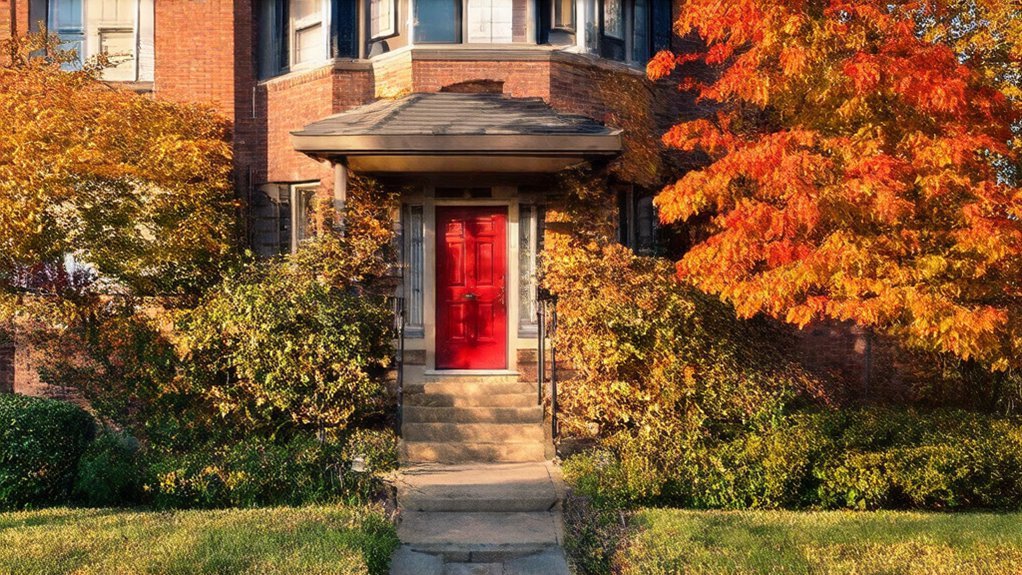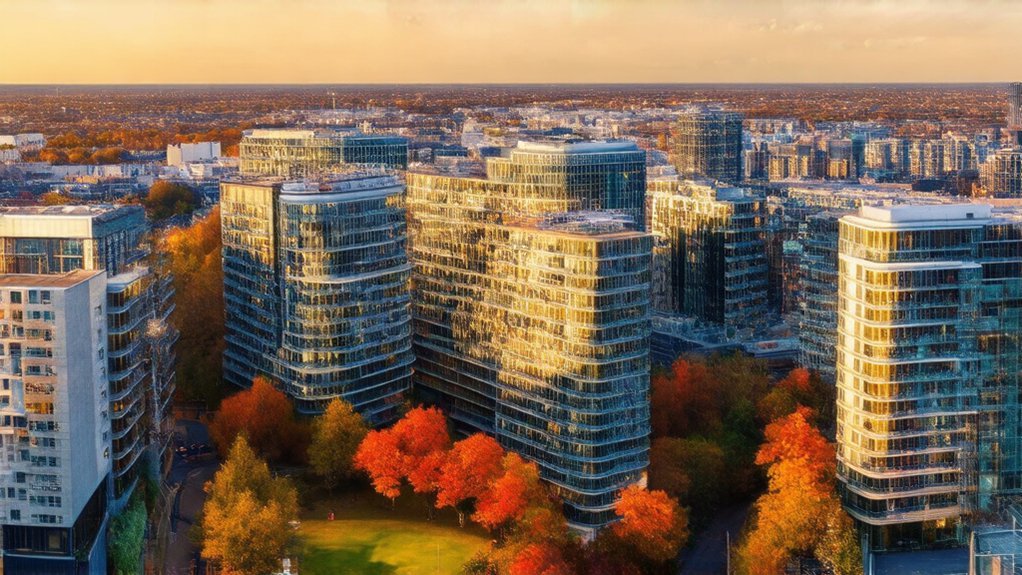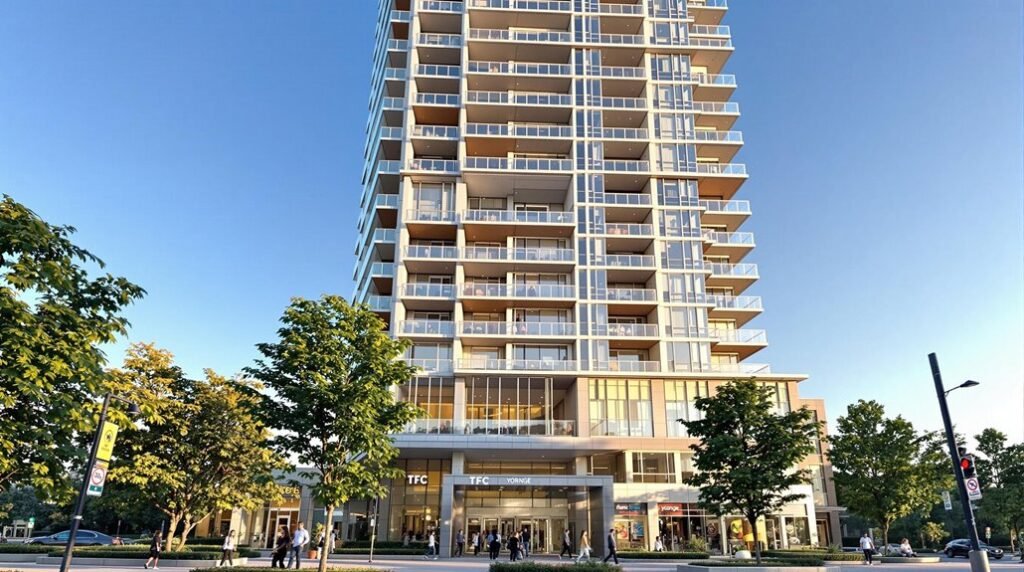You can negotiate better rental rates in North York’s 2025 market by timing your search strategically. Winter months offer more leverage with a 1.5% vacancy rate. Focus on areas like Yonge-Finch where rental listings have increased by 51.3%. Present yourself as an ideal tenant with proof of reliable payment history. Offer longer lease terms to strengthen your position. Research current rates through TRREB’s MLS® System to support your negotiation. Target furnished units where prices have risen 10.97% while unfurnished units show decreases. Consider alternative neighborhoods like Bayview Village or Willowdale for competitive options. This overview just scratches the surface of available negotiation strategies.
Key Takeaways
- Negotiate during winter months when rental activity slows and vacancy rates reach 1.5%, increasing chances for better deals.
- Demonstrate strong tenant credentials and offer longer lease terms to strengthen bargaining position when discussing 2025 rates.
- Research comparable units through TRREB’s MLS System to establish fair market rates, focusing on areas showing price decreases.
- Target properties vacant for extended periods, especially in high-supply areas like Sheppard Avenue and new developments.
- Time negotiations 2-3 months before lease expiration, citing market data and rental price stabilization trends for leverage.
Current Market Overview North York

Volatility in North York’s real estate market creates both challenges and opportunities for rent negotiation. You’ll find significant shifts in rental dynamics across different neighborhoods. The market shows strong demand particularly around Yonge and Finch areas where rental activities remain robust. Single-family rentals have seen increased interest from larger households seeking more space.
Here’s what you need to know about the current market:
- Property Types and Demand
- Condos and apartments lead rental activity
- High demand exists near transit hubs
- Townhouses offer alternative rental options
- Luxury properties maintain steady rental interest
- Location Preferences
- Yonge Street corridor remains most sought-after
- Bayview Village attracts premium renters
- Willowdale shows strong rental growth
- Sheppard Avenue sees increased development
- Market Drivers
- Population growth fuels rental demand
- Young professionals seek transit-accessible units
- Students contribute to consistent demand
- New immigrants boost rental requirements
- Price Trends
- Moderate rent increases due to expanded inventory
- Premium rates in luxury neighborhoods
- Competitive pricing near subway stations
- Variable rates based on property amenities
The market currently favors landlords but offers negotiation opportunities. Early preparation is essential as first-time renters face heightened competition in this dynamic market. With mortgage rates hovering around 5.23%, many potential buyers are turning to rentals, intensifying competition. You’ll find more flexibility in areas with new developments where supply has increased.
Properties near Finch and Sheppard stations command higher rates but may offer better amenities. Consider that luxury rentals in York Mills and Hogg’s Hollow maintain stable pricing due to their exclusive nature and limited availability.
Understanding Local Rental Pricing

Market knowledge is only half the equation – understanding North York’s specific rental pricing helps you negotiate effectively. You’ll need to know that North York’s rental rates currently average $3.37 per square foot. This places it among the GTA’s pricier areas but still below Downtown Toronto’s $3.71 per square foot. Toronto’s median rent of $2,499 shows consistent growth across all property types. Winter months typically present better opportunities for negotiating lower rates.
The city’s vacancy rate at 1.5% indicates a highly competitive rental environment that affects negotiation power. Here are key pricing factors to evaluate:
- The overall Toronto average rent is $2,699 with a median of $2,500
- One-bedroom units in Toronto average $2,248
- North York’s rates fluctuate between downtown prices and outer GTA rates
- Recent trends show mixed patterns with some areas increasing while others decrease
You should note that North York has experienced notable changes. While some areas saw decreases in unfurnished one-bedroom units, furnished units increased by 10.97% in recent months. This contrasts with Toronto’s overall 13% decrease from the previous year.
Compare these price indicators:
- The GTA’s least-to-most expensive rental gap is now $670
- Markham leads at $4.00 per square foot
- Downtown Toronto remains the highest-priced area for all unit types
- Etobicoke increased by 3.20% while Scarborough decreased by 2.11%
Understanding these price variations gives you leverage in negotiations. You’ll want to track monthly changes as they vary greatly by neighborhood.
Remember that furnished units in North York have shown different trends than unfurnished ones. This knowledge positions you to make informed decisions about rental choices and negotiation strategies.
Leverage Points for Better Deals

Several powerful leverage points exist for securing better rental deals in North York’s competitive market. You’ll find more room for negotiation during winter months when rental activity slows down. Properties that have remained vacant for extended periods often come with more flexible landlords willing to make concessions. With rising home prices across the Greater Toronto Area, more potential tenants are seeking rental options. Tenant preferences are increasingly focused on larger spaces and enhanced amenities.
Your strongest bargaining positions come from being an ideal tenant. You can demonstrate this through:
- A pristine credit report showing consistent payment history
- Bank statements reflecting stable income and responsible spending
- Reference letters from previous landlords praising your reliability
- Proof of employment with a reputable company
- Documentation of rental insurance and a clean background check
Timing plays a significant role in your negotiating strategy. Properties needing minor updates or repairs give you additional leverage. You can offer to handle small improvements in exchange for reduced rent. The 51.3% increase in listings compared to last year has created a tenant-friendly environment for negotiations.
Consider proposing a longer lease term of 18-24 months to demonstrate commitment.
Focus on properties where landlords face specific challenges. Units with lower occupancy rates or those requiring immediate tenants present prime opportunities. You can strengthen your position by offering upfront payments or automatic monthly withdrawals.
Market conditions in North York currently favor strategic negotiation. Rising interest rates have pushed more potential buyers into the rental market.
However, increased condo rental listings have created more choices. This supply shift gives you room to compare multiple properties and leverage competing offers for better terms.
Building Your Negotiation Strategy

Building a successful rental negotiation strategy starts with laying the groundwork well before you meet with potential landlords. You’ll need to gather market data from TRREB’s MLS® System and research average rental prices in North York. This information will help you understand current market conditions and identify reasonable negotiation points. With rental price stabilization expected due to affordability limits reaching their peak, timing your negotiations strategically could work in your favor. Starting discussions 2-3 months ahead of your current lease expiration will give you maximum negotiating leverage.
Understanding your tenant rights under the Residential Tenancies Act will strengthen your negotiating position.
Follow these steps to create your negotiation plan:
- Document your rental history and create a tenant profile that highlights:
- Your record of on-time payments
- Property maintenance skills
- Length of previous tenancies
- References from past landlords
- Prepare your market research:
- Collect data on comparable units in the area
- Note price differences between property types
- Track recent rental trends in North York
- Document nearby amenities and transit access
- Develop your negotiation approach:
- Set your target rent reduction amount
- List alternative concessions you’ll accept
- Prepare to offer a longer lease term
- Draft talking points about property conditions
- Create your presentation materials:
- Write a formal rent reduction request
- Compile market comparison data
- List property improvements needed
- Include your maintenance capabilities
You’ll want to practice your negotiation script before meeting with the landlord. Keep your tone professional and focus on mutual benefits.
Have your documentation ready to support your position. Remember to follow up all verbal agreements with written confirmation to protect both parties’ interests.
Timing Your Rental Search

Timing plays a critical role in securing the best rental deals in North York’s competitive market. You’ll want to focus on the winter months when rental prices tend to drop due to lower demand. This is especially true around Yonge and Finch where competition can be fierce during peak seasons. Senior housing demand is expected to significantly impact rental availability as 90% of residents over 55 prefer to age in place.
Start your search early and monitor these key market indicators for 2025:
- Empty units with “For Rent” signs in building windows
- Moving trucks frequently spotted in specific neighborhoods
- Construction cranes marking new development sites
- Property management offices with multiple listing boards
- Open house signs in targeted areas
The rental market in 2025 will face significant demand driven by population growth. With the Bank of Canada rate cuts expected, rental demand may increase as more people enter the buying market. According to CMHC predictions, rental supply shortages will continue to affect urban markets. You’ll need to balance this with expected changes in interest rates and housing prices. The GTA’s predicted 1% decline in condo prices might affect rental rates. This creates opportunities for negotiation during off-peak seasons.
Follow these strategic timing tips:
- Begin your search 60-90 days before your intended move
- Focus on winter months for better negotiating power
- Monitor online platforms daily for new listings
- Connect with real estate agents for early listing access
- Track local development projects that might affect rental prices
Use real-time data from rental platforms to stay informed about market trends. You’ll find better success by analyzing recent rental transactions in your desired area.
This research helps set realistic expectations for rent prices and strengthens your negotiating position.
Presenting Yourself as Ideal Tenant

A landlord’s ideal tenant goes beyond just paying rent on time. You’ll need to present yourself as a complete package that offers stability, reliability, and long-term commitment.
Start by showcasing your financial strength through these key elements:
- Provide recent pay stubs and employment verification letters
- Share your credit score and credit history report
- Submit bank statements showing consistent savings
- Offer references from previous landlords
- Consider proposing advance rent payments
You can demonstrate your reliability through these actions:
- Document your history of on-time rent payments
- Highlight your understanding of tenant responsibilities
- Show willingness to handle minor maintenance tasks
- Express commitment to following building rules
- Present a clean rental history record
With $2,000 average rent for one-bedroom apartments in North York, competition is fierce among prospective tenants. The low vacancy rates in North York’s rental market make it crucial to stand out as a potential tenant. Emphasize your intention for long-term residency by:
- Discussing your connection to the neighborhood
- Mentioning local employment or family ties
- Explaining why you’ve chosen this specific area
- Offering to sign a longer lease term
- Sharing your future plans in the community
Your market knowledge will also set you apart:
- Research current rental rates in North York
- Understand the property’s competitive advantages
- Know the building’s amenities and features
- Show awareness of market trends
- Demonstrate you’ve done your homework on the neighborhood
This thorough approach will position you as a standout candidate in North York’s competitive 2025 rental market.
Market Research Tools

When negotiating rent in North York‘s dynamic market, you’ll need reliable research tools to make informed decisions. The Toronto Regional Real Estate Board (TRREB) reports offer extensive data about rental trends and pricing patterns. You can track key metrics like the 51.3% increase in condo rental listings and the current average rents of $2,499 for one-bedroom units. While days on market are up 24% year-over-year, this indicates more room for negotiation with landlords.
Online platforms provide real-time market insights for different neighborhoods. Focus on tools that show:
- Interactive maps highlighting rental prices across North York’s neighborhoods
- Price comparison charts for units in Yonge Street, Bayview Village, and Willowdale areas
- Monthly rental trend graphs showing seasonal fluctuations
- Demographic data overlays showing population density and growth
- Transportation access maps showing proximity to subway stations and major roads
Websites like The Realty Bulls and Boardwalk offer detailed property listings and market analysis. You’ll find current vacancy rates and rental price trends specific to North York’s micro-markets. The CMHC website provides broader economic indicators that affect rental prices. Similar to the First Home Savings Account program for buyers, renters should explore financial planning tools to optimize their housing expenses.
Local real estate agents’ websites often feature neighborhood-specific reports and market updates. These resources help you understand the 25.2% increase in rental transactions and months of inventory metrics. Many sites offer email alerts for new listings in your preferred areas.
Use these tools to create an extensive market analysis before negotiations. Compare similar units in your target neighborhoods and track price changes over time. This data-driven approach strengthens your negotiating position with concrete market evidence.
Competitors and Alternative Options

Armed with market research data, you’ll want to explore your competitive options in North York’s rental landscape. North York offers several neighborhoods with similar affordability levels that you should consider in your search. North Mills Valley, Pleasant View, Henry Farm, Victoria Village, and Glenfield-Jane Heights each provide unique advantages for renters. The proximity to schools and local amenities makes these areas particularly attractive to families. Understanding the local market rates is essential for making informed rental decisions.
You’ll find these alternative housing options in the area:
- Condos serve as the most common entry point for many renters.
- Townhouses offer more space but come at a higher price point.
- Low-income apartments provide federally funded options through housing programs.
- Furnished units include utilities for added convenience.
- Specialized units cater to pet owners and accessibility needs.
Beyond North York, you should explore these expanding areas:
- Eglinton West features strong transit connections.
- Weston offers competitive pricing and growth potential.
- Black Creek attracts students near York University.
- Downsview-Roding-CFB provides abundant green spaces.
- Flemingdon Park combines high-rises with natural settings.
Property managers in these areas use various strategies to attract tenants. Don Valley West prices have decreased 16.3%, creating opportunities for negotiation. They’re focusing more on end users rather than investors.
You’ll notice extensive management services and accurate pricing based on thorough evaluations. Managers also implement targeted marketing campaigns and adjust strategies based on seasonal demand.
Understanding these competitive options strengthens your negotiating position. You can leverage information about alternative neighborhoods and housing types during rent discussions with potential landlords.
Legal Considerations When Negotiating

Understanding Ontario’s rental laws provides essential boundaries for your negotiation strategy. The Residential Tenancies Act (RTA) sets clear guidelines for both landlords and tenants in North York. You’ll need to guarantee your negotiations align with these legal requirements to avoid future disputes.
When negotiating your rent, keep these key legal points in mind:
- Your landlord can’t increase rent more than once every 12 months
- Above-guideline increases require LTB approval
- Rent reductions are automatic if property taxes decrease considerably
- You must receive 90 days’ notice for any rent increase
- All agreements should be documented in writing
The Landlord Tenant Board oversees rental disputes in Ontario. Post-dated cheques cannot be required by landlords as a condition of renting. You can challenge improper rent increases within 12 months of implementation. Hiring a home inspector can strengthen your negotiating position by identifying any safety or maintenance issues. Remember that your landlord must provide proper documentation for any above-guideline increases. This includes proof of extraordinary expenses or capital improvements. Scheduling an in-person meeting with your landlord can lead to clearer communication and better negotiation outcomes.
Your negotiation rights differ depending on whether you’re a new or existing tenant. New tenants have more flexibility in negotiating initial rent amounts. Current tenants must work within the RTA’s guidelines for rent increases. You can’t waive your legal rights under the RTA through negotiation.
Your landlord must respect entry rules during negotiations. They need to provide 24-hour written notice before entering your unit. This applies even when showing the property to potential new tenants.
Make sure any agreement about maintenance responsibilities or operating costs complies with RTA regulations. Keep records of all communication and agreements during negotiations.
Long Term Rental Market Outlook

Beyond the legal framework of rental negotiations, you’ll want to reflect on the broader market forces shaping North York’s rental landscape. The data points to several key trends that will affect your rental prospects in 2025 and beyond.
The rental market shows these notable patterns:
- Supply is increasing with condo rental listings up 51.3% compared to 2023. This gives you more options but demand remains strong due to population growth.
- Prices have seen a temporary dip with one-bedroom units averaging $2,499 (down 5%) and two-bedrooms at $3,216 (down 1.9%). Don’t expect this trend to last as demand continues to outpace supply. The national housing market predicts a 5.0% price increase by 2025, which will likely influence rental rates accordingly.
- Interest rates are projected to decrease in 2025. This will drive more home sales but won’t reduce rental demand considerably. The current mortgage rate of 5.23% continues to push many potential buyers toward rentals.
You’ll need to reflect on these long-term factors:
- Investment in rental properties continues to grow especially near Yonge and Finch plus Sheppard Avenue areas.
- REITs are expanding their focus on multifamily and affordable housing projects which will add to future supply.
- Population growth and immigration will maintain steady demand particularly from students and young professionals.
The market outlook suggests you should act strategically. While there’s more rental inventory now prices will likely rise again as demand remains strong.
Areas near transit and development zones like Bayview Village offer good prospects for stable long-term rentals. Watch for new affordable housing projects as they may provide additional options in the coming years.
Conclusion
You’ll need to combine market knowledge, timing, and negotiation skills to secure the best rental deal in North York’s 2025 market. Research local prices extensively and gather documentation to support your position. Stay flexible with move-in dates and building choices to increase your leverage. Remember that successful negotiations depend on preparation and understanding both your needs and the landlord’s perspective. Keep track of market trends to time your search effectively.


















